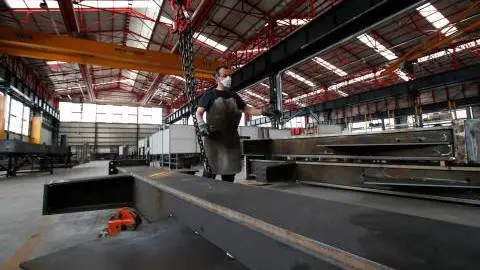The largest quarterly decline in Eurozone GDP on record
Eurozone GDP declined by 12.1% in the second quarter of 2020, the largest quarterly decline on record. While GDP has already started to climb thanks to reopenings, a V-shaped recovery is wishful thinking
| -12.1% |
Eurozone GDPSecond quarter |
Some records are never to be beaten. Think of Alan Shearer’s Premier League goals, Wilt Chamberlain’s 100 point basketball game, Eddy Merckx’s victories in cycling. The second quarter eurozone GDP figure should probably go on that list as well; it would be great if it were never to be beaten.
The -12.1% Q-o-Q growth rate is the worst ever recorded and a pretty difficult one to interpret. It is a shocking drop, but completely understandable as the economy was shut for a considerable period during the quarter. It, therefore, doesn’t tell us all that much about the general state of the economy, which is usually why one would look at GDP figures in the first place. Still, the deeper the lockdown, the higher the chance of more significant lasting damage to the economy and therefore the extent of the decline is still relevant.
That decline has been relatively similar between countries with Germany, France and Italy all showing between 10 and 14% GDP declines. There is one worrying outlier though, which is Spain. Spain lagged Italy and France in its recovery of nowcast data during 2Q, but the difference is larger than expected and with reopening measures being locally reversed for 3Q, Spain looks set for a prolonged slump. Outside of Spain, the divergence between countries has been smaller than expected. This is a cautious positive sign for further Eurozone divergence in the recovery phase.
The hard part of this recovery is set to start about now
Looking forward, this recession is not like any other precisely because it has been caused by a lockdown of the economy. Judging from nowcast data, the eurozone economy started to grow again around the end of April, early May. Monthly figures have suggested a considerable bounce back in retail sales and industrial production, but that is largely just a mechanical improvement thanks to the reopening of shops and factories.
The hard part of this recovery is set to start about now. First of all, slightly higher trending new Covid-19 cases increase the risk of reversed reopenings, and we're already seeing local signs of that. Secondly, from this point on, cautious increases in unemployment and bankruptcies and weak investment will bring to light more characteristics of a general economic slump. These factors are likely to drag on for some time, making a swift recovery to pre-corona levels of GDP out of the question.
This publication has been prepared by ING solely for information purposes irrespective of a particular user's means, financial situation or investment objectives. The information does not constitute investment recommendation, and nor is it investment, legal or tax advice or an offer or solicitation to purchase or sell any financial instrument. Read more
Download
Download snap
31 July 2020
Covid-19: The shocking numbers are in This bundle contains 8 Articles